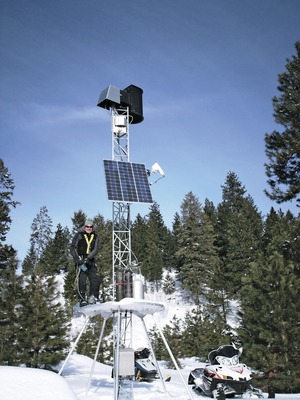
Idaho Power, which depends upon hydropower to serve about 500,000 customers in southern Idaho and eastern Oregon, is trying to augment its water supply by cloud seeding.
While the concept dates from the 1940s, Idaho Power is pushing to expand its decade-old program to increase snowpack—and stronger runoff for its hydroelectric generation facilities—by as much as 15% annually.
Cloud seeding involves injecting silver iodinde into supercool liquid water portions of a cloud, says engineer Shaun Parkinson, Idaho Power's water resources leader. The iodide then forms into ice crystals and adds to a mountain snowpack. Using trace chemistry to test snowpacks, studies done specifically for Idaho Power match other national and international studies that show a 5% to 15% increase in snowpack. "We usually report in the range of 5 to 15, but we are tending to see in the upper end of that," says Parkinson. Official Idaho Power documents state recent annual returns of 13%.
That translates to 200,0000 additional acre-feet of water for the company's three-dam Hells Canyon complex annually, generating approximately 100,000 megawatt-hours, or enough to power roughly 7,900 homes. And those numbers are conservative, as the Idaho Power cloud seeding project has now expanded to 36 remotely operated ground-seeding sites, just over half the goal for the next few years, Parkinson says.
Idaho Power now spends about $1 million annually, but calculates the extra water returns more than a $2 million value. "Once we are not doing as much research and our projects are built out, that [return] should be at 4:1 or 6:1," Parkinson says about the growth potential.
Dr. Arlen Huggins, former director of the Desert Research Institute cloud seeding program based in Reno, Nev., a national leader partially funded by the National Oceanic Atmospheric Association, says that as organizations struggle to meet the water demands of users, snowpack augmentation has become increasingly popular in the West.
Studies have found that the trace elements of silver iodide—measured in parts per trillion—have no effect on the environment, scientists say.
Some of the best research results, according to the Desert Research Institute, have come from studies in the Rocky Mountain and the Sierra Nevada ranges.
And while projects—most famously Southern California Edison and Pacific Gas and Electric programs—started in the 1950s, there are now even lowland agencies helping fund upper-basin agencies' programs to improve reservoir strength, Huggins says.
Idaho Power began its operation in the Payette watershed north of Boise, sending runoff through the company's Hells Canyon complex, a trio of dams that provides roughly half of all hydro generation in the company's 17-dam portfolio. In that area, they average 19,000 grams of silver iodide injected via the ground generators and 30,000 from aircraft.





Post a comment to this article
Report Abusive Comment